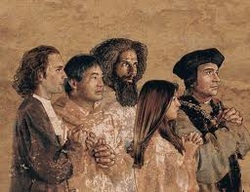
What does your scribe think of Halloween? I think it’s on the wrong date. Some students asked me to offer a Mass for the Faithful Departed at Santa Paula cemetery on November 2, which I will do. If we are going to celebrate “death,” we should do so on November 2, and we should do it properly. On All Souls Day, we celebrate death in Christ, which is really something to celebrate. We celebrate the fact that these poor souls made it the finish line with their faith intact; they have only heaven to look forward to (usually after a stout stint in Purgatory). We pray for these suffering but holy and blessed souls on November 2nd, and we celebrate Christ’s triumph.
But “Halloween,” as it has been reinvented, has nothing to do with either All Souls Day or All Saints Day. Yes, I am aware that the word “Halloween” comes from “All Hallows Eve,” but our American holiday is far from anything Christian. Instead of celebrating death in saintly fashion (as a glorious supernatural birth into eternal life), “Halloween” celebrates death in zombie fashion (as a horrifying unnatural extension of earthly life). It’s got it exactly backwards, and this perversion fascinates only the backwards thinking (alas, we all think at least a bit backwards now and then).
But to the point of my Mom-friend’s request: how do good Catholics, especially good Catholics with ten rambunctious children, deal with Halloween? Everyone else is casing the neighborhood for candy, and do we expect our kids to stay inside? All the other kids are charging through the streets in fantastic outfits, and do we expect ours to keep still?
I suggest, as have many before me, that we face Halloween head on. Dress your children up, but dress them up as saints, and send these saints out to battle the zombies. If the neighbor kids can dress up like psychopaths and witches, your kids can dress up like Maximilian Kolbe and Therese of Lisieux. It’s a free country, after all. Do they want something scary? Send them out as St. Lawrence, with a gridiron under his arm, or as St. Denis, carrying his head, or as St. Lucy, with her eyes on a platter. The martyrs not only did not fear death, but they did not fear eternal life, and sold their earthly lives in full confidence of obtaining real life in the next world. While the pagans trivialized death, the martyrs transformed death. We can speak sanctity to vulgarity; your children can proclaim the Gospel of Life on this night of death.
Depending on where you live, and how far the Culture of Death has advanced in your neighborhood, you may not want to send your kids out tonight. In many parishes, such as my last parish, we hold an All Saints Day party on All Hallows Eve. Children dress up like saints, including the martyrs, compete for prizes, pray some prayers, and get some candy. I would always dress up like St. John Bosco, meaning I simply donned a Roman hat to go with my black cassock, but many children put great effort and imagination into their costumes. Many of them were truly inspiring and exciting.
And then some of the children, fortified by Christian fellowship, prayers, and candy, headed out into the world to take on the skeletons and vampires. Good must overcome evil, and if your children are up to the challenge, let the saints march through our streets to overcome fear with faith, to bring Christ’s light into death’s darkness.
I have no doubt that the demonic is behind much of our culture’s fascination with death at this time of year. We must take the perversion of All Saints and All Souls Day seriously. Perhaps the best way to do that is to retake the holiday as much as we can. After all, we Catholics hold the copyright on “Halloween”—it’s our word, and it’s our Solemnity. Don’t let All Saints Day and All Souls Day sink into the Culture of Death and its mire without a fight. Make the effort to celebrate them properly, so as to be a light in your neighborhood on this otherwise night of darkness.


 RSS Feed
RSS Feed